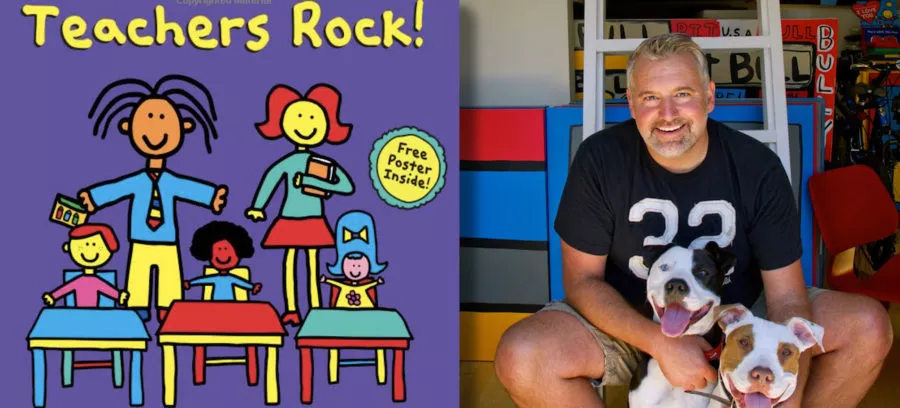 With messages of acceptance, kindness and love, Todd Parr’s books -- like It’s OK to Be Different and the I Love You Book -- are timely and timeless and have long been the favorites of kids everywhere. NEA Today caught up with Parr to talk about one of our favorite books, Teachers Rock!, which is about all the ways teachers change the world (and that also comes with a free Back-to—School poster!).
With messages of acceptance, kindness and love, Todd Parr’s books -- like It’s OK to Be Different and the I Love You Book -- are timely and timeless and have long been the favorites of kids everywhere. NEA Today caught up with Parr to talk about one of our favorite books, Teachers Rock!, which is about all the ways teachers change the world (and that also comes with a free Back-to—School poster!).
What inspired you to write Teachers Rock?
Todd Parr: I wanted to celebrate teachers who I feel can be under-appreciated but who have a lifelong impact on their students. For instance, my second grade teacher Ms. Dona really helped me learn to read. I had reading problems and dyslexia and now, because of Ms. Dona, I’m writing children’s books. I wanted to celebrate teachers like her that don’t give up on kids. Over the years I’ve been in schools all over the country and see firsthand all that teachers do. I felt like not enough people were acknowledging the hard work they do every day, from cleaning up messes to helping kids handle issues at home to buying their own classroom supplies. It seemed like people expected that from teachers but weren’t talking about how wonderful or how life-lasting their efforts are.
Who was your favorite teacher?
TP: My second grade teacher Ms. Dona, as strict as she was. But it was tough love and she helped me overcome so many challenges. Also, Mrs. Judson, my fourth grade teacher, who allowed me to express myself. I had all kinds of crazy ideas and I wanted to put on my own play. I had no idea what I was doing. This was Wyoming -- there was no such thing as theater! But I had a very vivid imagination and Mrs. Judson facilitated that. I thought she was just letting me have fun, but looking back I realize she was letting me explore my creativity.
What’s your message to teachers for National Teacher Day?
TP: That you really are appreciated! I know that these days it’s even more challenging with budget cuts and administrative issues, but through it all you go to school every day and teach kindness and empathy and humanity. It is very much appreciated and all that you do does not go unnoticed! You not only teach kids to read and write, but also how to be better human beings. That challenge is greater today than it has ever been, but you create environments that are safe places for kids to have fun and learn.
Your books contain messages of tolerance and embracing differences. Why is that important for kids?
TP: I was held back in second grade because I couldn’t read and the other kids made fun of me. On top of knowing I had a learning problem, I was being made fun of and I remember vividly how hard that was. When I got older, I realized there weren’t a lot of messages for kids about how it’s OK to be different. Not all of us are the same or good at everything. Some of us are slow learners or readers and some excel at it. And that’s OK. I felt different, I felt I didn’t fit in or belong, and that was OK. We spend so much of childhood trying to be like someone else or be like the cool person. But I want kids to know that if they’re not, it’s OK and to embrace their differences. The underlying premise of most of my work is empowering kids to be confident and to feel good about who they are, whether they’re in a wheelchair or wear glasses or have learning problems.
A lot of kids today are bullied for their religion, or country of origin or immigration status. What’s your message to these kids? What books could be helpful for teachers to read to them?
TP: In Be Who You Are kids are encouraged to be proud of where they’re from and their family. The teacher has the harder part, acting as a springboard, but maybe the books can lead to discussions about differences and where people are from and the importance of realizing how things really are around the world. This hate is learned behavior and it comes from someplace. Educators can help kids learn new messages, like we are all important, we are all different, we all get sad, we all get mad, and we all matter. Let’s embrace that. I try to keep it simple. I use simple artwork, simple colors. The message can be heavy but the delivery is simple.
You sign all your books “Love, Todd”. How did that become your signature sign off at the end of your books?
TP: It’s a way to tie up a simple book without answers and say one final positive thing for readers to remember. In my books, I feel like I’m writing a letter to someone I care about. I’m writing and sharing my feelings and emotions and want to help you feel better and be confident. I embraced my struggles, and so can you. That’s the underlying message of everything I do, and I mean it. I want to help.


